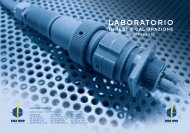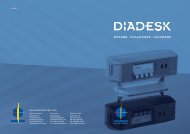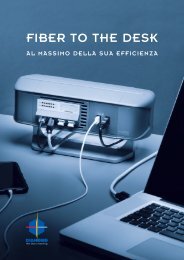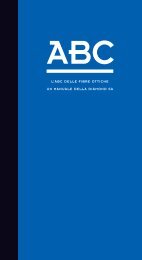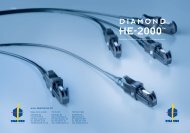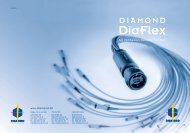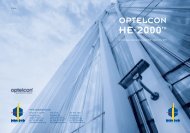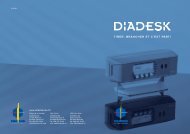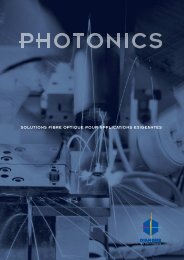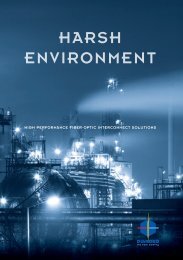Brochure Photonics
You also want an ePaper? Increase the reach of your titles
YUMPU automatically turns print PDFs into web optimized ePapers that Google loves.
PHOTONICS<br />
INDUSTRIAL FIBER OPTIC INTERCONNECT SOLUTIONS
PHOTONICS<br />
PHOTONICS 1<br />
PHOTONICS<br />
Fiber Optics are being used increasingly in commercial applications because of it’s bandwidth capacity,<br />
enviromental durability, and it’s ability to be deployed in numerous applications and markets. The light transmitted<br />
by fiber optics can be used as a power source, a digital signal transfer, or for analog analysis in sensing<br />
and measurement applications.<br />
In the past optical fibers were used primarily in the data and telecom industries, but new research has resulted<br />
in many new applications for fiber optic components. These applications cover markets such as: bio-medical,<br />
measurement instruments, laser delivery and sensing.<br />
Fiber optic solutions that satisfy the increasing demands for customer specific challenges and requirements,<br />
can only be offered from companies like Diamond who exhibit the following competencies thanks to a vertically<br />
integrated structure:<br />
Mechanical<br />
Integrated Ceramic production (pressing, sintering, machining)<br />
Precision metal machining (drilling, milling, EDM), with expertise in hard metals, (Ti, WC, Kovar, stainless)<br />
High quality plastic injection<br />
Ultra-high precision lapping<br />
Ultra-high precision drilling<br />
Fiber-ferrule polishing<br />
Optical<br />
Fiber Active Core Alignment (ACA)<br />
Active Polarization Orientation (APO)<br />
Expanded beam technology: contact (PS), non contact (PSf, PSb, PSl, PSc, PM-PS)<br />
Splice technology (MM, SM, PM, dissimilar fiber, PCF fibers)<br />
Assembly<br />
Epoxy Polymerization<br />
Modules termination (Active or Passive, PM, PS)<br />
Vacuum sealing (epoxy)<br />
Active component alignment and laser welding<br />
Clean room packaging<br />
Measurement<br />
High quality and reliable test and measurement of fiber optic components, in an accredited laboratory with<br />
the capability to simulate multiple environments.
TECHNOLOGIES TECHNOLOGIES PHOTONICS 3<br />
DIAMOND TECHNOLOGIES FOR FIBER OPTICS<br />
Composite ferrule<br />
Diamond technologies are all based on a composite ferrule.<br />
Instead of a full ceramic ferrule, Diamond has opted for a composite ferrule<br />
formed of a zirconia ceramic sleeve and a titanium metal insert.<br />
Advantages<br />
Custom drill sizes from 80μm to 800μm<br />
Superior ultra polishing<br />
Allows plastic deformation for our Active Core Alignment<br />
Custom ferrules for multi-fiber technology<br />
Ferrule with ultra low Outside Diameter (OD) tolerance<br />
Active Core Alignment (ACA)<br />
Ferrule 2.5 mm<br />
Insertion Loss mainly depends on two parameters; the lateral offset between the two fiber cores and the angular<br />
offset (between the two fiber core axis).<br />
Diamond’s Active Core Alignment (ACA) is the technology Diamond utilizes to control these variables.<br />
During this process the endface is permanently deformed, after the fiber has been polymerized in place, in<br />
order to center the core of the fiber with the mechanical axis of the ferrule.<br />
Advantages<br />
Ultra low Insertion Loss (IL)<br />
- 0.1dB Grade for SM Telecom fibers<br />
- low IL for small core diameters<br />
High Return Loss (RL)<br />
Applicable on PM fibers, outperforming IL performance of any other technology<br />
Available in all products<br />
Titanium insert<br />
Customizable<br />
fiber hole<br />
0.1dB Grade - SM Ultra Low Loss<br />
The 0.1dB Grade is Diamond’s proposal for a Grade A definition for IEC quality grade standards. At this time<br />
there is no formal definition for the Grade A in IEC standards, nevertheless, Diamond is promoting this quality<br />
grade under the 0.1dB Grade name.<br />
0.1 dB Grade Optical Interface<br />
ACA, eccentricity<br />
< 0.125μm<br />
Exit angle < 0.4°<br />
0.1dB Grade ferrules: low diameters tolerance < 0.2μm<br />
Ultra polish with 100% Endface inspection<br />
This quality grade retains it’s name for the performance obtained with ITU G.652 D fiber which corresponds<br />
to a 0.1dB at 97% limit, random mated according to IEC 61300-3-34.<br />
Applications<br />
High quality networks<br />
High speed networks and equipments<br />
Interferrometry systems<br />
VIS/NIR - SM Low Wavelength<br />
Small core fibers used mostly for visible and near infrared wavelengths (VIS/NIR), have not been addressed by<br />
standard groups. The ACA technology allows Diamond to provide the following specifications.<br />
VIS/NIR Optical Interface<br />
ACA, eccentricity<br />
< 0.125μm<br />
Exit angle < 0.6°<br />
0.1dB Grade ferrules: low diameters tolerance < 0.2μm<br />
Ultra polish with 100% Endface inspection<br />
Before ACA<br />
Excentric Fiber Core<br />
Applications<br />
Bio-Medical diagnostics and treatment<br />
Visible light laser<br />
ACA Crimping<br />
After ACA<br />
Fiber Core Centered<br />
Core<br />
9µm<br />
λ=980nm<br />
MFD=6µm<br />
IL
INTERFACES AND STANDARDS INTERFACES AND STANDARDS PHOTONICS 5<br />
OPTICAL AND CONNECTOR INTERFACES<br />
As a global company Diamond standardizes it’s products according to existing IEC standards. Each termination<br />
is composed of an optical interface and a connector interface. The following section lists the applicable<br />
standards for Diamond’s products. For complete information please refer to our website catalog.<br />
Connector Interfaces – IEC 61754<br />
This standard is a collection of physical features on a connector assembly that defines a specified style. It consists<br />
of those minimum features that are functionally critical during the mating and un-mating sequences of<br />
the connector with its counterpart component. The interface defines the sizes, relative locations, and tolerances<br />
for each of the features. It includes references, definitions, and rules for creating and interpreting the<br />
standard drawings.<br />
Optical Interfaces – IEC 61755<br />
An optical interface standard is a multi-part collection of the requirements necessary in order to comply with<br />
the optical functionality specifications for a defined interface between two optical fibers. It consists of those<br />
essential features that are functionally critical to the optical attenuation and return loss performance of an<br />
optical interface in the mated condition. This standard provides general information on single-mode optical<br />
interfaces, defining the location of the fiber core in relation to the datum target and the following key parameters:<br />
lateral offset, end face separation, end face angle, end face high index layer condition.<br />
Connector and Optical interface Combination<br />
Field interferometers benefitting from robust, ultra high performance Diamond environmental<br />
DMI/Micro AVIM PM.<br />
Connector<br />
Interface<br />
Optical Interface<br />
Ultra Low Loss<br />
Standard or VIS/NIR PS PSi PSf PM PM-PS<br />
(0.1dB Grade)<br />
SM MM<br />
E-2000<br />
F-3000<br />
DMI<br />
FC<br />
x<br />
x<br />
x<br />
x<br />
x<br />
x<br />
x<br />
x<br />
x<br />
x<br />
x<br />
*<br />
x<br />
x<br />
x<br />
x<br />
x<br />
x<br />
x<br />
*<br />
x<br />
*<br />
x<br />
x<br />
x<br />
x<br />
x<br />
x<br />
x<br />
x<br />
*<br />
IEC 61754-15<br />
IEC 61754-28<br />
Diamond<br />
IEC 61754-13<br />
* other standards<br />
(TIA, EN) exist too<br />
LSA (DIN)<br />
AVIM<br />
Midi AVIM<br />
Mini AVIM<br />
Micro AVIM<br />
SC<br />
ST<br />
MU<br />
F-SMA<br />
DiaLink<br />
x<br />
x<br />
x<br />
x<br />
x<br />
x<br />
x<br />
x<br />
x<br />
x<br />
x<br />
x<br />
x<br />
x<br />
x<br />
x<br />
x<br />
x<br />
x<br />
*<br />
*<br />
x<br />
x<br />
x<br />
x<br />
x<br />
x<br />
x<br />
x<br />
x<br />
x<br />
x<br />
*<br />
x<br />
x<br />
*<br />
x<br />
*<br />
*<br />
x<br />
x<br />
x<br />
*<br />
x<br />
x<br />
x<br />
x<br />
x<br />
x<br />
x<br />
x<br />
*<br />
IEC 61754-3<br />
ESCC 3420/002<br />
ESCC 3420/001<br />
ESCC 3420/001<br />
ESCC 3420/001<br />
IEC 61754-4<br />
IEC 61754-2<br />
IEC 61754-6<br />
IEC 61754-22<br />
IEC 61754-32<br />
IEC 61755-1<br />
IEC 61755-1<br />
Diamond<br />
Diamond<br />
Diamond<br />
Diamond<br />
Diamond<br />
Diamond<br />
Standards<br />
* available on demand, but not qualified<br />
In the following pages the emphasis is on Diamond Optical Interfaces.<br />
For details on Connector Interfaces and IEC standardized Optical Interfaces, please refer to our standard<br />
catalog.<br />
End customer application using Diamond’s E-2000 PM low wavelength to analyze DNA structure.
PRODUCTS PRODUCTS PHOTONICS 7<br />
POLARIZATION ORIENTATION (PO)<br />
Polarization plays an important role in the industrial photonics market. Sensors and communication systems<br />
have been designed using Polarization Maintaining or Polarizing fibers. DIAMOND supplies high-quality solutions<br />
to Polarization Maintaining (PM) and Polarizing (PZ) fiber optical interfaces for optimal control of the<br />
signal’s polarization state.<br />
Panda Bow-Tie Panda Double-Clad<br />
Oval Core Panda PCF Oval Inner Clad<br />
PM product family<br />
Depending on the application, different optical performances are required. In order to meet these requirements,<br />
the PM product family is divided into two classifications. First, the PM+ with the highest PER values<br />
and the best mechanical properties. Second, the PM standard class with very good optical values and a wide<br />
range of different connector types.<br />
PM+ connectors<br />
The best Polarization Extinction rate<br />
The PM+ connector types are designed to achieve the highest possible and Polarization Extinction Ratio (PER),<br />
this with excellent Insertion Loss (IL) and Return Loss (RL) values. The optical performance is guaranteed by<br />
the selected connector variants with good mechanical properties<br />
and low angular tolerances.<br />
Thanks to very high PER values, the PM+ connector family<br />
opens up new possibilities in the development<br />
and design of new measuring and diagnostic<br />
devices.<br />
The connector key for a Polarization Maintaining connector can be aligned to the stress members (Passive<br />
Polarization Orientation, PPO) or to the true optical axis (Active Polarization Orientation, APO).<br />
Advantages and features<br />
Active Polarization Orientation (APO) method<br />
Excellent low Insertion Loss (IL) values<br />
Highest PER Value<br />
Homologated fiber for wavelength ranges from 532 to 1550nm<br />
Advantages<br />
Ultra low Insertion Loss<br />
High Extinction Ratio<br />
High Return Loss<br />
PM connectors<br />
For a wide range of connector types<br />
Thanks to good optical values and a large number of connector variants, there is a suitable connector in the<br />
right configuration for a large number of applications.<br />
PM (Polarization Maintaining) optical interface<br />
The use of Diamond Active Polarization Orientation with a special Active Core Alignment process, limit any<br />
residual stress in sensitive PM and PZ fiber. Low Insertion Losses (IL) combined with high Polarization Extinction<br />
Ratios (PER) and higher Return Losses (RL) are achieved over very broad spectral ranges thanks to a combination<br />
of accurate optical and mechanical design. The PM+ products use a refined assembly process allowing<br />
for higher PER value.<br />
PM Optical interfaces<br />
Exit angle < 0.6° Ferrule radius 10÷20 mm<br />
0.1dB Grade ferrules with diameter tolerance < 0.2μm Core apex
PRODUCTS PRODUCTS PHOTONICS 9<br />
POWER SOLUTION EXPANDED BEAM<br />
TECHNOLOGIES<br />
Diamond uses different methods for expanded beam alignment, depending on the final use of the assembly.<br />
In this section, we will present the technologies using a GRIN lens spliced at the end of a fiber to realize a collimated<br />
beam dedicated to a connection. Other Expanded Beam technologies exist for non-contact connection<br />
and input/output application.<br />
These expanded MFD resulting from the use of a collimated beam, diminish the power density at the glass air<br />
interface. Un-wanted particles at the glass air interface (the connector endfaces) will resist to more power<br />
before causing a failure in a connection.<br />
PM-PS (Power Solution collimated for PM fibers)<br />
Polarization Maintaining (PM) fibers using the Power Solution (PS) optical interface benefit from the same<br />
Expanded Beam GRIN lens benefits. This more delicate technology has been homologated only on specific<br />
fibers and require a full homologation for any new fibers. A limited choice of connector mechanical interface<br />
is compatible with these products: E-2000, DMI / Micro AVIM, Mini AVIM.<br />
In these products, the MFD surface is increased by a factor 15 compared to the PM MFD.<br />
PS Optical Interface:<br />
0.1dB Grade ferrules with diameter tolerance < 0.2μm<br />
ACA with low exit angle < 0.15°<br />
Polarization slow axis – Key angle +/- 2°<br />
Ultra polish with 100% endface inspection for PC 0° and APC 4°<br />
PS (Power Solution collimated)<br />
The Power Solution (PS) optical interface is based on contact Expanded<br />
Beam GRIN lens technology. It has been qualified at 1550nm using ITU<br />
G.652-D and ITU G.657-B3 fibers up to 5W using E-2000 and at 1050nm<br />
using Corning HI-1060 fiber at 1W using F-3000 connectors.<br />
Applications<br />
Free Space Telecomunication<br />
RF over fiber<br />
Lidar<br />
Sensing<br />
In these products, the MFD surface is increased by a factor 15 compared<br />
to the SM MFD.<br />
PS Optical Interface:<br />
0.1dB Grade ferrules with diametertolerance
PRODUCTS PRODUCTS PHOTONICS 11<br />
SPECIAL INTERFACE PRODUCTS<br />
Applications with fibers are not only based on physical contact, but also other types of interfaces. Light must<br />
be injected in fibers and must get out to illuminate a target too. In some cases, feedthrough to go through<br />
dissimilar ambient are necessary. The following products corresponds to the standardized solutions developed<br />
for these applications. Others are regularly designed or customized for specific applications.<br />
MAS – MULTIPURPOSE ADAPTER SYSTEM<br />
The Multipurpose Adapter System (MAS) is a hybrid flexible adapter. The Universal adapter<br />
is mounted on a chassis or used on a bench and is available in FC or Mini<br />
AVIM. The other side of the adapter is changeable on the fly and<br />
is available in the following mechanical interfaces: E-2000,<br />
SC, LSA DIN, ST, F-3000 (100% compatible with<br />
the LC), FC (wide and narrow key).<br />
Advantages<br />
Easy use<br />
Low insertion loss<br />
Large choice of mechanical interface<br />
Easy cleaning of internal connectors<br />
Interchangeable adapters (upper),<br />
Universal Adapter (lower)<br />
Applications:<br />
Measurement instruments<br />
Light sources<br />
V-FT – VACUUM FEEDTHROUGH<br />
Feedthroughs have been produced by Diamond for twenty years using a proven epoxy sealing technology.<br />
Diamond has standardized this sealing process and is now offering an off-the-shelf solution for the<br />
Vacuum Feedthroughs.<br />
Diamond offers V-FT’s based on a standard ConFlat (CF) flange, (DN16 size,<br />
OD 40mm). These flanges can be used with rubber seals for High Vacuum,<br />
or with one-time-use copper seals for Ultra-High Vacuum. Thanks to the<br />
MAS universal flange, most of the optical connectors can be mounted on the<br />
atmospheric side. Whereas on the vacuum side, due to the environment<br />
limitations, only the following connectors are available;<br />
AVIM, Mini AVIM, FC, DMI, DIN (LSA).<br />
Advantages<br />
Applications<br />
Low leak rate at wide temperature range Semiconductor vacuum Chamber<br />
Low Insertion Loss<br />
Space pressurized vessels<br />
Fiber type independent<br />
Vacuum fiber qualification<br />
Compatible with all Optical Interfaces Nuclear plant<br />
Wide range of mechanical interface<br />
Wide range of flange accessories<br />
IMOD – INTERFACE MODULE<br />
The Interface Module (IMOD) is used to terminate a connector for free space applications. Various options are<br />
available to fix the ferrule in a location optimal for your application.<br />
Without any stopper;<br />
for applications which does't<br />
require specific tolerances or<br />
exact ferrule axial positioning.<br />
With ferrule ZrO2 cylinder<br />
stopper, for a good axial<br />
repeatability.<br />
With ferrule front face<br />
stopper, for superior axial<br />
repeatability.<br />
These options can be adapted to most mechanical interface for PC, and APC versions, such as: E-2000, SC,<br />
F-3000, ST, LSA (DIN), FC, Mini AVIM and F-SMA (SMA 905).<br />
Reference Patchcords<br />
Reference connectors are a critical component in metrology and have been defined in detail for telecom<br />
applications in IEC 61755-2-4 and IEC 61755-2-5.<br />
To comply with these standards, Optical reference connectors are manufactured with specific tolerances and<br />
selected single mode fiber with restricted tolerances on the Mode Field Diameter (MFD). Only this way can<br />
the measurement attenuation variability be limited in reference connectors. The repeatability of those measurements<br />
can be contained to ± 0.1 dB when randomly varying the reference connectors.<br />
Diamond manufactures high performance reference connectors using the standardized composite ferrule, as<br />
well as "Active Core Alignment" (ACA) technology, which allows for the minimization of the fiber core<br />
eccentricity and the control of the angular misalignment.<br />
Diamond can provide reference connectors on other fibers not defined in the IEC standards with similar specification,<br />
where eccentricity and exit angle are always defined and measured. Individual fiber specification can<br />
change with each fibers.<br />
Advantages<br />
Easy implementation<br />
High Position Reproducibility<br />
Long service life<br />
Applications:<br />
Laser launch<br />
Instrument front panel connection<br />
Custom adapters
SERVICES<br />
LABORATORY<br />
The test and calibration laboratory at DIAMOND SA has been accredited by the Swiss Accreditation Service<br />
SAS since March 2002. We are accredited as testing laboratory STS 333 for fiber optic components and<br />
as calibration laboratory SCS 101 for fiber optic measurement instruments in accordance with the standard<br />
ISO / IEC 17025:2005. The accredited test and calibration laboratory STS 333 / SCS 101 performs measurements,<br />
tests and calibrations not only for DIAMOND SA, subsidiaries and DIAMOND representatives all over<br />
the world but also directly for external customers.<br />
ISO 7 cleanroom<br />
The worldwide market for fibre optic solutions used within fields that are very sensitive to environmental contamination,<br />
such as medicine, laboratories, space, research, life sciences and industry, is experiencing steady<br />
growth. Diamond has responded to this growing demand by creating a new ISO 7 cleanroom (class 10'000<br />
according to FED STD 209E), in order to supply products such as connector sets, pigtails, patchcords, adapters<br />
and mechanical parts that are cleaned and packaged in a controlled environment.<br />
Processes inside the Diamond cleanroom include cleaning, drying, controlling and packaging, and these are<br />
preceded by a preparation and preconditioning process outside the cleanroom.<br />
For details of the processes, or to enquire about a customized process , please contact us.<br />
Cleanroom main characteristics<br />
Class: ISO 7 (according to norm DIN EN ISO 14644-1)<br />
Type: Turbulent air flow<br />
Flow rate: Min. 40 air exchanges/h<br />
Filters: 3 ULPA U15 filters<br />
Air flow: 3,600 m 3 /h total<br />
Overpressure: 24 Pa<br />
ESD-compliant: Yes<br />
Surface: 40 m2<br />
Power supply: Lights and filters are under UPS
en V 12/18<br />
Headquarters<br />
DIAMOND SA<br />
via dei Patrizi 5<br />
CH-6616 Losone TI<br />
Tel. +41 58 307 45 45<br />
info@diamond-fo.com<br />
www.diamond-fo.com




